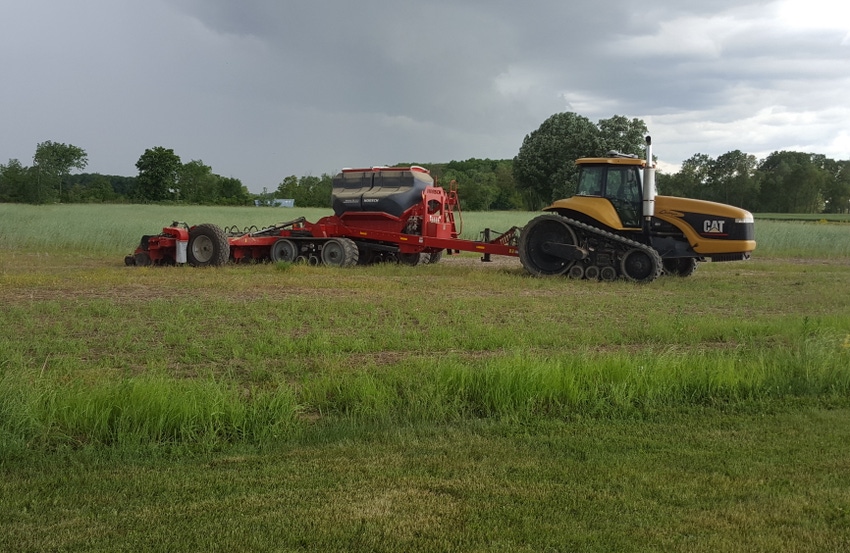
Think Different
Adam Perry, Ohio grower
10 years no-till, 7 years cover crops
Higher yields took 6 years but worth it
Drastically reduced crop insurance
Reduced time spent on tractor
“It’s easy for farmers to give this a try for three years because of a financial incentive and then give up because they’re not seeing the results,” he says. “I didn’t see things stabilize on my operation until year five, and like I said before, that’s kind of hard to swallow at first. But it’s worth it. It’s worth every penny and every second.”
------------
Adam Perry is a numbers guy. And after putting pencil and calculator to work on a strategy to improve his margins he saw two options: Rely on ever-increasing operating loans to spread production costs over greater acreage, or be more efficient with the land and equipment he already owned. For Perry, the answer was clear.
Perry turned to no-till 10 years ago on his 1,000-acre operation in northwest Ohio, and he started growing cover crops six years ago. He admits he was anxious to see his yields go up and his costs go down. And while it certainly wasn’t an overnight fix, he knows the cover crops are doing their job, because the numbers are starting to show for themselves.
Higher yields
“This has probably been our best year (2017) as far as yields go,” Perry says. He planted only beans, but typically follows a soybean and corn rotation. “Our area was down on yields — especially for beans—and my yield was above average. I think that’s a direct result of the combination of both no-till and cover crops. I was yielding about 45 to 47 bushels and the county average was around 40 to 42. That’s a big difference when you’re just looking at the economic side of things.”
Perry had a strong support system when he initially became interested in cover crops. Several local farmers encouraged him to experiment, even when he had his own doubts about them.
“I remember thinking, ‘How in the world is this going to work?’ But I had people insisting it was worth the shot.”
Worth the wait
Perry says his yields went down during the first two years – a result he wasn’t anticipating. “That was hard to swallow,” he says. “But everyone around had me had a positive attitude about it and kept me going. I was expecting an overnight miracle and when that didn’t happen, it was disappointing.
Fast forward four years, and now Perry is growing cereal rye across most of his operation and he’s glad he listened to that support system who encouraged him along the way.

Ohio farmer Adam Perry is glad he stuck with cover crop, as results took time to build. “I think the combination of no-till, cover crops and irrigation are going to help us save much more money in the long run and keep our yields at an all-time high,” he says.
“The first couple of years were tough,” Perry says. “It made me question everything, but everyone said, ‘Hang in there,’ but I just wasn’t sure how long I could do it. By year five I was coming up with average yields. And now in year six, we’re above average.”
Reduced crop insurance
Perry has even said he’s cut his crop insurance as a direct result of more consistent yields – and may drop it all together.
“We’ve had some really dry years lately, but it still doesn’t hit the trigger for crop insurance to pay.” Rebuilding his soil’s resilience and water holding capacity has delivered yields too consistent for a payout, even when Perry insures against his own yield history.
“We’re building a positive yield history,” he says. “It’s still climbing. That tells me our risk has been mitigated with cover crops.”
Right now, he carries only 50% coverage – and will weigh whittling that down even further if his yields continue their trend of improvement and reliability.
“For me, the best way to insure your operation is to ensure yield,” Perry says. “The bottom line is that what we’re doing is working for us, and it’s minimizing our risk tremendously.”
Perry says he plans to expand his irrigation system with the funds he’d otherwise be using on crop insurance programs. “I think the combination of no-till, cover crops and irrigation are going to help us save much more money in the long run and keep our yields at an all-time high,” he says.
Time is money
Perry has also found significant cost savings when it comes to one of the simplest elements of a management practice – time.
“To me, time is money,” Perry says. “If I’m spending less time out there on a tractor, I’m putting money back in my pocket because I’m using my time much more wisely.”
But at the end of the day, Perry says farmers won’t get to where he is as far as yields and profits go with the wrong attitude – and sometimes, changing that attitude is harder than it seems.
“It’s easy for farmers to give this a try for three years because of a financial incentive and then give up because they’re not seeing the results,” he says. “I didn’t see things stabilize on my operation until year five, and like I said before, that’s kind of hard to swallow at first. But it’s worth it. It’s worth every penny and every second.”
About the Author(s)
You May Also Like




